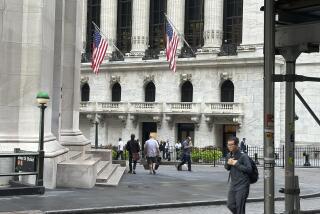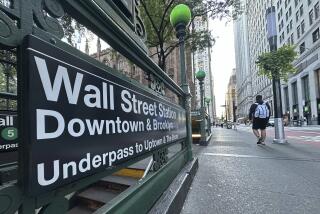Interest Fear, Forecasts Drop Dow Record 91.55
- Share via
Fears of rising interest rates and pessimistic forecasts by some leading market analysts prompted a major sell-off in the stock market Tuesday, with the Dow Jones average of 30 industrial stocks falling 91.55 points, its biggest one-day point drop ever.
The fall in the Dow, to a close of 2,548.63, was yet another indication of how investor uncertainty has triggered sharp point swings in that key market index. Investors appear to be increasingly fickle, alternating between fears of an impending bear market and optimism that the five-year-old bull market still has a lot of life left.
Only two weeks ago, on Sept. 22, the Dow set an all-time record for a single-day gain, soaring 75.23 points amid optimism that interest rates might not rise as much as had been feared.
‘Very Nervous’
“It’s late in the (bull market), and a lot of people are very nervous,” Michael Metz, market strategist at the Wall Street firm of Oppenheimer & Co., said in explaining Tuesday’s decline.
The 91.55-point fall surpassed the previous record single-day decline of 86.61 points set Sept. 11, 1986. Then, as was the case Tuesday, the sell-off was fueled by bad news on interest rates and by computer-driven stock-selling programs initiated by big institutional investors.
But on a percentage basis, the Dow fell only 3.47% on Tuesday, less than the 4.61% drop on Sept. 11 last year and far less than the record 12.82% decline on Oct. 28, 1929. That 38.33-point drop in the Dow, to a close of 260.64, marked the beginning of the Great Depression.
Tuesday’s sell-off was sparked in part by falling bond prices early in the day, driven down by investor fears that the Federal Reserve Board would tighten credit and raise interest rates. Bond prices fall when interest rates rise.
The decline also was triggered by concerns that recent sharp rises in bond yields would prompt institutional investors to switch money out of stocks into bonds, Metz said. Yields on four-year Treasury notes rose Tuesday to the highest level in two years. The average yield was 9.24%, up from 7.89% at the last comparable auction on June 24.
Yields of 9% or above on medium-term Treasury issues are “a trigger point” for pension funds and other institutional investors to increase their purchases of bonds, Metz said.
Additional selling of stocks came from big institutional investors, whose computerized trading programs gave signals to sell stocks and buy stock-index futures instead.
Correction Predicted
Selling also came amid reports that some leading market prognosticators, concerned that the market was not rising with enough strength, predicted a short-term correction. Most influential was Robert R. Prechter, editor of the Elliott Wave Theorist, a Gainesville, Ga., newsletter. He reportedly told investors late Monday that the market was due for a short-term correction that would see the Dow index fall to as low as 2,300.
However, Prechter, who could not be reached for comment Tuesday, apparently did not change his long-term forecast that the Dow will rise to as high as 3,600 next year.
Many other market watchers agreed, saying that Tuesday’s fall was merely part of a short-term correction and not the start of a bear market.
Some analysts expect the Dow index to hit as high as 3,000 this year, thanks in part to robust corporate earnings, a strong economy and expectations that the dollar’s decline has ended.
“The market was due for a little correction,” said Werner E. Keller, director of research for the Los Angeles brokerage of Bateman Eichler, Hill Richards. He and other analysts said the 116-point rise in the past two weeks indicated that many stocks were overbought.
Investors had become too bullish in recent days, a factor that contributed to Tuesday’s sell-off, said Peter G. Eliades, editor and publisher of Stockmarket Cycles, a Los Angeles-based newsletter, whose prediction of a short-term correction also sparked some selling Tuesday. That is because when nearly everybody is bullish, they are fully invested in stocks and thus there is not enough money left on the sidelines to buy more stocks and push prices even higher, Eliades said.
Analysts were encouraged by the fact that Tuesday’s fall occurred on volume of only 175.6 million shares, which, although up from Monday’s 159.65 million shares, was still far below the 200-million-plus share levels that often indicate panic selling.
Encouraging Fact
“That’s relatively light volume considering the strength of the sell-off,” said Al Frank, editor and publisher of the Prudent Speculator, a Santa Monica newsletter.
Also encouraging, Frank said, was the fact that most stocks were not as hard hit on a percentage basis as the 30 blue-chip stocks in the Dow industrial index, which fell 3.47%. The NASDAQ composite index of over-the-counter stocks declined 6.12 to close at 447.51, a fall of only 1.35%. The American Stock Exchange market-value index slipped 3.89 to close at 355.44, a decline of 1.08%, and the New York Stock Exchange composite index of all its listed stocks declined 4.46 to end at 178.98, a drop of 2.43%.
Standard & Poor’s index of 400 industrials fell 11.44 to 372.02, and S&P;’s 500-stock composite index was down 8.86 to 319.22.
1,322 Stocks Down
Declining issues outpaced advancers by a margin of about 4 to 1 on the NYSE, with 1,322 stocks down, 326 up and 321 unchanged.
Leading the NYSE most-active list Tuesday was Tenneco, which rose $1.375 to close at $61.25 amid speculation that it might be a takeover target.
Among the big losers were International Business Machines, which plunged $5.50 to close at $151; Digital Equipment, which fell $3.75 to $194; Du Pont, which declined $4.25 to $118.50; Merck, which skidded $7 to end at $201; Philip Morris, off $4 to $113.50, and CBS, down $4.25 to close at $215.75.
More to Read
Inside the business of entertainment
The Wide Shot brings you news, analysis and insights on everything from streaming wars to production — and what it all means for the future.
You may occasionally receive promotional content from the Los Angeles Times.










